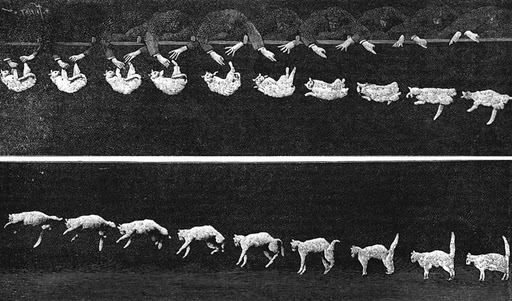Cats have a unique ability known as the “righting reflex”. By utilizing the principles of physics, they are able to rotate their bodies and prevent any harm when falling. How do cats accomplish this feat, and is it something humans can also do?
Cats possess remarkable agility and flexibility. They can effortlessly maneuver through narrow spaces and jump to great heights. Despite engaging in such daring activities, they always manage to land safely on all four of their paws.
But how do they accomplish this? And do cats possess the exclusive ability to defy death in this manner?
Marey’s Experiment on Falling Cats
In the 19th century, scientists were puzzled by certain animals’ ability to change their body orientation while falling, with cats being the most well-known example.
The Scientist Who Studied Falling Cats
Étienne Jules Marey, a renowned scientist, conducted an unusual experiment in 1894. He wanted to unravel the intricacies of a falling cat, so he decided to drop a cat upside down and document its motion using a technique called chronophotography. This method involves capturing a sequence of images to study different phases of movement.
Using this method of photography, he was able to capture the various stages of the cat’s descent and featured them in the esteemed Nature journal.

Étienne Jules Marey’s photographs from 1894 challenge the previous belief that cats rotate their bodies by pushing against the person dropping them. In Marey’s photos, the cats show no rotation at the start of the fall but instead flip mid-free fall, acquiring angular momentum in the process.
However, this seems to defy the laws of physics.
According to Newton’s Law of Motion, an object cannot change its motion without an external force acting on it. So, how do cats manage to defy the laws of physics?
How Do Cats Rotate Their Bodies While Falling?
When a cat begins to fall, it is initially upside down with its four paws facing the sky and its back towards the ground. The only force acting on the cat at this point is gravity, which is pulling it downwards in a vertical direction.
The cat needs an external force to change its body position and land on its paws when falling. However, since there is no such force in the air, the cat uses its muscles to rotate and flip its body.
Animals have a natural reflex called the righting reflex, which allows them to reorient their body while falling in order to land safely on their feet. This reflex has been observed in various mammals, such as cats, guinea pigs, rabbits, rats, and primates.
Cats and geckos use angular momentum to reorient their body
When cats and geckos need to change their direction, they rely on the principle of conserving angular momentum. This means that they can adjust their position without using any external forces.
In the case of cats, Marey’s images have revealed an interesting behavior. When a cat starts to fall, it instinctively arches its back. This action effectively divides the cat’s body into two distinct parts.
To understand this phenomenon, we can consider the upper and hind parts of the cat as separate rigid cylinders. Each cylinder has its own rotational axis, which allows the cat to maintain its balance while reorienting its body.
At the beginning, the cat bends its body to create two distinct segments – the upper and lower halves, which have different rotational axes. The cat then starts rotating its head towards the camera while extending its hind legs and pulling in its front legs. This action is similar to figure skaters pulling in their arms to increase their spinning speed. Cats use the same principle when they fall.
During the rotation, the front part of the cat’s body rotates around 180° at the waist, while the hind part rotates in the opposite direction by about -5°. This counter-rotation ensures that the total angular momentum remains unchanged. As a result, the opposite spins of the two body parts cancel each other out, resulting in a net angular momentum of zero.
The cat starts by contracting its front legs to rotate its front half, and then contracts its hind legs to align its hind part with the front. This causes the cat to eventually face the ground. As its head and front paws face the ground, the cat extends its front legs while contracting its hind legs. This allows the hind legs to catch up with the front legs. By reversing this process, the cat can rotate its hind part and align it with the front. When all four paws of the cat are facing the ground, it can land safely and comfortably. Unfortunately, humans do not possess this incredible ability. However, humans do have a similar reflex called the postural righting reflex, which includes visual righting reflexes, labyrinthine righting reflexes, and neck righting reflexes, among others. While these reflexes may not save our lives in the event of a fall, they do help us maintain proper body orientation and posture.
Summary
There was a cat in New York that fell from a height of 32 floors and landed on concrete. Despite the fall, the cat only suffered a chipped tooth and a collapsed lung. Surprisingly, after just 48 hours, the cat was ready to go back home. The ability of cats to instinctively right themselves has proven to be a valuable and life-saving advantage for cats worldwide.
Despite their ability to quickly right themselves, cats are not invulnerable to the serious risks of falling from great heights. Research has found that 96.5% of cats survive falls from tall buildings. However, many of these cats still experience bone fractures and long-term physical damage. This demonstrates that while cats possess the instinct to correct their position mid-air, they do not always escape these accidents without any harm.
